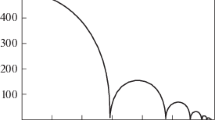Abstract
Employing Rayleigh's method, the collapse of a vaporous bubble in an incompressible liquid with surface tension is analysed. The expressions of time versus radius, bubble-wall velocity and pressure developed at collapse are thus introduced.
Finally, the numerical solution of velocity and pressure field in the liquid surrounding the cavity is also given.
Similar content being viewed by others
References
Knapp, R. T., J. W. Daily and F. G. Hammitt,Cavitation, McGraw-Hill, New York (1970).
Rayleigh, Lord, On the pressure developed in a liquid during the collapse of a spherical cavity,Phil. Mag.,34, August (1917), 94–98.
Knapp, R. T., and A. Hollander, Laboratory investigations of the mechanism of cavitation,Trans. ASME,70 (1948), 419–435.
Poritsky, H., The collapse or growth of a spherical bubble or cavity in a viscous fluid,Proc. First U.S. Natl. Congr. Appl. Mech. (ASME), (1952), 813–821.
Author information
Authors and Affiliations
Additional information
Communicated by Chien Wei-zang
Rights and permissions
About this article
Cite this article
Jing-chuan, H. Flow field at collapse of a cavity. Appl Math Mech 10, 259–263 (1989). https://doi.org/10.1007/BF02014620
Received:
Issue Date:
DOI: https://doi.org/10.1007/BF02014620




